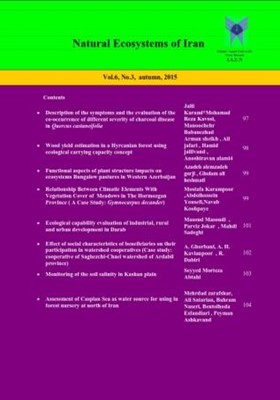تأثیر ویژگیهای اجتماعی بهرهبرداران بر مشارکت آنها در تعاونیهای آبخیزداری (مطالعه موردی: تعاونیآبخیزداری حوزه آبخیز سقزچیچای استان اردبیل)
الموضوعات :اردوان قربانی 1 , امیرحسین کاویانپور 2 , روح الله دبیری 3
1 - دانشیار گروه مرتع و آبخیزداری، دانشکده فناوری کشاورزی و منابع طبیعی، دانشگاه محقق اردبیلی، اردبیل، ایران
2 - دانشجوی دکتری علوم مرتع، دانشگاه علوم کشاورزی و منابع طبیعی گرگان، گرگان، ایران
3 - - دانش آموخته کارشناسی ارشد آبخیزداری، دانشگاه ارومیه، ارومیه، ایران
الکلمات المفتاحية: مشارکت, مسائل اقتصادی و اجتماعی حوزههای آبخیز, تعاونی آبخیزداری, ویژگیهای اجتماعی,
ملخص المقالة :
جهت جلب مشارکت ساکنان یک حوزه آبخیز برای شرکت در برنامه های آبخیزداری، عوامل تأثیر گذار باید مورد توجه قرار گیرد. در این تحقیق ویژگیهای فردی- حرفه ای و آموزشی- ترویجیروستائیان عضو تعاونی آبخیزداری حوزه آبخیز سقزچی چای (استان اردبیل) و تأثیر این عوامل بر مشارکت آن ها در تعاونی های آبخیزداری بررسی شده است. این تحقیق به روش پیمایشی انجام و پرسشنامه ای جهت گردآوری داده ها تهیه شد. جامعه آماری شامل بهره برداران عضو تعاونی آبخیزداری روستاهای سوها، سقزچی، حور، تفیه و رز به تعداد 115 نفر بوده اند که در داخل حوزه آبخیز سقزچی چای ساکن هستند. برای تجزیه و تحلیل داده ها از نرم افزار SPSS استفاده شد. نتایج بدست آمده از توصیف ویژگی های فردی و حرفه ای بهره برداران حوزه آبخیز سقزچی چای عضو تعاونی های آبخیزداری شامل: سن، شغل اصلی، میزان تحصیلات، نوع حرفه در روستا، میزان مهارت و ... نشان داد، اولاً تنها افراد سالخورده و با سواد کم، کشاورز و دامدار و با مهارت متوسط هستند که بیشترین تمایل را برای مشارکت در تعاونی آبخیزداری نشان داده اند. جوانان تحصیل کرده باور مناسبی نسبت به موفقیّت تعاونی های آبخیزداری ندارند و بیشتر تمایل به مهاجرت و کمتر دلبستگی به ماندن در روستا و انجام فعالیت های مختلف در قالب تعاونی ها را از خود نشان داده اند. دیدگاه بهره برداران نسبت به مشارکت در کلاس های آموزشی برای افزایش مشارکت قابل توجه بوده و درخواست برگزاری کلاس های آموزشی دارند. همچنین با توجه به معنی داری ضریب مقایسه من- ویتنی در سطح 01/0=α، اعضاء آشنا با مفهوم قرق و آشنا با شرکت های تعاونی روستایی، بیشترین مشارکت را در تعاونی آبخیزداری داشته اند.
References
1-Arayesh B. & J. Hosseini, 2010. Regression analysis of effective factor on people participation in protecting and using natural resources in Ilam province. Journal of Agricultural Economics and Development 5(2): 228-234.
2-Azizi Khalkhili, T. 2007. Impacting structures on rural participation in watering management; the case of Dorudzan Dam watering network, M.Sc. Thesis of Agriculture, Shiraz University.
3-Bakhshi, J., S.R. Masihi, & H.R. Katanforoosh, 2009. The impact of socioeconomic factors on range improvement. Forest and Rangeland Journal 84:45-49.
4-Coelho, V.S. & A. Favareto, 2008. Questioning the relationship between participation and development. World Development 36(12): 214-223.
5-Hedjazi, Y. & E. Abbasi, 2007. An investigation of the factors affecting participation executives in the plan of balancing livestock with grazing capacity. Journal of the Iranian Natural Resources 60 (2): 683-692.
6-Heydarpour, Z., H. Shabanali Fami, A. Asadi, & I. Malekmohammadi, 2008. A study on the role of membership in forestry ay cooperatives in the development of forestry resources in the western part of Mazandaran province. Journal of Agricultural Science and Natural Resources 15(1):1-9.
7-Hossein Pour, A. 1993. Analysis of participation necessity and identification of educational needs of forest dwellers for soil conservation and watershed management in Haraz Basin Amol Country Mazandaran province. M.Sc. Thesis of Tarbiat Modarres University. 107p.
8-Jalali, M. & E. Karami, 2006. Determinants of ranger’s participation in rangeland cooperatives in Kurdistan province. Pajouhesh and Sazandegi 70: 35-45.
9-Khalighi, N., B. Chakoshy, & M. Kia, 2006. A Study of the Role of Population, Indigenous Technology and Ownership in People's Participation in Rangelands Proper Exploitation (Chahkand Watershed, Birjand). Journal of the Iranian Natural Research 59(3): 741-757.
10-Makhdoom, M. 2006. Fundamental of Land use planning, Tehran University Press. Seventh Edition. 289p.
11-Mohammadi GH. 2000. Factors influencing villagers' participation in watershed management plans. Jihad Magazine 261:59-64.
12-Najafinejad, A. 1997. Watershed management field manual, watershed survey and planning, FAO Conservation Guide. Gorgan University of Agricultural Sciences and Natural Resources, Gorgan. Press, 260p.
13-Nasrollahi, A., N. Ansari, & H. Mirdavoodi, 2004. Technical and social-economic factors affecting on degradation of Markazi province rangelands. 3rd National Conference of Rangeland and Range Management, 875-891 pp., Karaj, Iran.
14-Rouhi, F., H. Amirnejad, GH. Heydari, & J. Ghorbani, 2010. The role of social factors on rancher's participation in range management plans (Case study: Rangeland of Ghaemshahr). Journal of Rangeland 4(3): 474-483.
15-Salehi, L. 2007. The study of effective factors on people participation in watershed projects, Proceedings of the 4th National Conference on Engineering Sciences and Watershed Management of Iran, 1-7 pp., Karaj, Iran.
16-Samari, D., & S. Davari, 2010. Rural cooperatives and new agricultural cooperatives. Rural Development Institute (RDI) Publications, 103 p.
17-Sarmad Z, A. Bazargan, & A. Hejazi, 2007. Research methods in behavioral science. Tehran: Agah Publication.
18-Wang, X. 2001. Integrating water-quality management and land-use planning in a watershed context. Journal of Environmental Management 61(1): 25-36.
19-Zamani, GH.H. & B. Abadi, 2009. Effective social factors on farmer’s participation in establishment of watershed management cooperatives of Fars province. Co-operation and Agriculture 210-211: 117-134.


